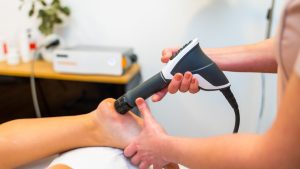The range and severity of hypermobility is hugely variable and no two people are alike in their presentation. The best treatment for hypermobility needs to be individualised and customised to you.
For many individuals, treatment focuses on improving joint stability, reducing pain, and preventing further injury. Here are a few ways this might be approached:
- Physiotherapy: Physiotherapy is one of the most effective treatments for hypermobility. A physical therapist can develop a tailored exercise plan to strengthen the muscles around hypermobile joints, improve posture, and enhance joint stability (Rombaut et al., 2013). Studies have shown that physical therapy interventions, particularly those focusing on strengthening and proprioception, are effective in reducing pain and improving function in people with hypermobility (Rombaut et al., 2010). They can also give advice for any orthotics or braces that may help provide additional support
- Pain Management: For those with chronic pain, medications such as NSAIDs (nonsteroidal anti-inflammatory drugs) or topical treatments can help alleviate discomfort. However, it’s essential to use these medications under the guidance of your doctor or pain specialist (Rombaut et al., 2010).
- Lifestyle modifications: Physiotherapists can assist individuals with hypermobility by teaching them techniques to perform tasks in ways that reduce pain or discomfort. They may also recommend ergonomic adjustments for workspaces (Buchbinder et al., 2015).
- Hydrotherapy: Exercising in water can be a gentle way to improve strength and flexibility without the strain of gravity on the joints. Hydrotherapy, often used in physical therapy settings, provides buoyancy, reducing the impact on hypermobile joints while still allowing for movement and exercise (Rombaut et al., 2013).
- Surgical Intervention: In more severe cases, when hypermobility leads to significant joint damage or instability, surgery may be considered. However, surgery is typically a last resort and is only recommended when other treatment options have been exhausted (Hakim & Grahame, 2003).
Hypermobility can lead to joint instability, pain, and an increased risk of injury. Several factors, including muscle weakness, overuse, and repetitive movements, can worsen the condition. Fortunately, the best treatment for hypermobility is one that is tailored for you. Strengthening and improving joint stability can help people manage their symptoms and lead an active life. If you are struggling with hypermobility, it’s important to work with a healthcare professional to create a personalized treatment plan that addresses your specific needs.
Sources:
- Buchbinder, R., Johnston, R. V., & Osborne, R. H. (2015). “Hypermobility and Osteoarthritis: Evidence from Clinical and Experimental Studies.” Journal of Rheumatology.
- Rombaut, L., Malfait, F., Cools, A., & D’hooge, R. (2010). “Efficacy of a Rehabilitation Program for Patients with Joint Hypermobility Syndrome: A Randomized Controlled Trial.” Rheumatology International.
- Hakim, A. J., & Grahame, R. (2003). “Hypermobility and Osteoarthritis: A Review of the Literature.” Rheumatology International.
- Rombaut, L., Malfait, F., & Cools, A. (2013). “Effects of Exercise on Joint Hypermobility Syndrome and Ehlers-Danlos Syndrome Hypermobility Type: A Review.” Physical Therapy in Sport.
- Gatt, A. (2020). “Physical Therapy Management for Hypermobility Syndrome.” European Journal of Physiotherapy.




